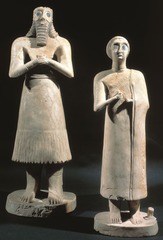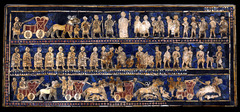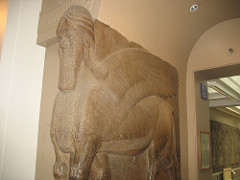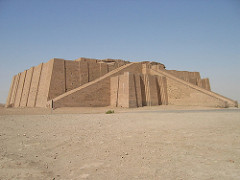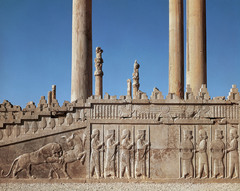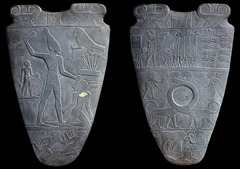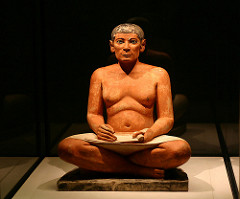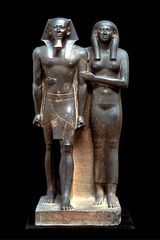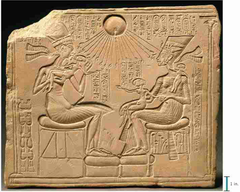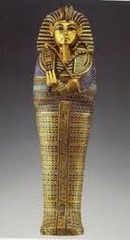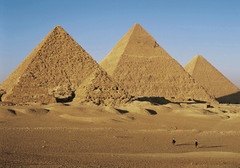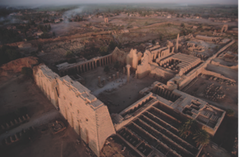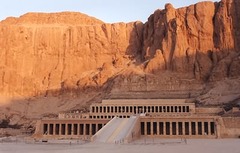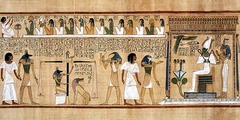Statues of Votive Statues
Period: Unit 2 Ancient Mediterranean
Medium: Gypsum inlaid with shell and black limestone
Artist: Unknown
Patron: Unknown
Date: 2700 B.C.E
Location: Sumeria
Form: Stylized structure,
Function: To take the place of a person to worship in the eyes of the gods
Content: Massive eyes and beard on the male figure
Context: Polytheistic Sumerian culture which lived in fear and respect of its deities
Standard of Ur
Period: Unit 2 Ancient Mediterranean
Medium: Wood inlaid with shell, lapis lazuli, and red limestone
Artist: Unknown
Patron: Unknown
Date 2600-2400 B.C.E
Location: Sumeria
Form: Twisted perspective, Stylized depiciton of society and warfare
Function: believed to have been used as a battle standard to be carried into war
Content: A beautiful depiction of Sumerian social class during peace and the depiction of Sumerian warfare
Context: Polytheistic culture with a defined and rigid set of social views and caste system
The Code of Hammurabi
Period:Unit 2 Ancient Mediterranean
Medium: Black Basalt
Artist Unknown
Patron: Unknown
Date:1792-1750 B.C.E.
Location: Babylon
Form: Twisted perspective and stylized form of the king and the god in the picture
Function: Depicts the divine right given to Hammurabi as he creates his code of law
Content: Hammurabi is depicted receiving the laws from one who we can assume is a deity due to his horned headdress, Hammurabi is depicted as being around the same height as the deity
Context: Polytheistic civilization with one monarch, Hammurabi, who was born with "divine right" to rule
Lamassu
Period: Unit 2 Ancient Mediterranean
Medium: Alabaster
Artist: Unknown
Patron: Unknown
Date: 720-705 B.C.E
Location: Dur Sharrukin
Form: Stylized, patterned beards, horned headdress
Function: used as guardian figures within cities.
Content: Human animal mixture, wears a horned headdress which was synonymous with deities
Context: Polytheistic culture with an emphasis on the monarchy, and animals.
White Temple and its Ziggurat
Period: Unit 2 Ancient Mediterranean
Medium: Mud Brick
Artist: Unknown
Patron: Unknown
Date: 3500-3000 B.C.E
Location: Uruk
Form: Massive size, lots of straight lines and rectangles
Function: A massive base for a temple. Built this way as a "stairway to heaven"
Content: Temple and terrace for indoor and outdoor rituals
Context: Polytheistic civilization with the temples focus being on the deity Anu who was the sky god
Audience Hall of Darius and Xerxes
Period: Unit 2 Ancient Mediterranean
Medium: Limestone
Artist: Unknown
Patron: Darius and Xerxes
Date: 520-465 B.C.E
Location: Persepolis
Form: Lots of relief sculptures, built in a massive way to dwarf viewers
Function: For state sponsored festivals, receptions and ceremonies
Content: Lamassu gates, stylized scenes taking place,
Context: Built by King Darius and Xerxes of the Persian empire which was a very wealthy and dominant power until Alexander the Great dismantled the empire and destroyed the hall.
Palette of King Namar
Period: Unit 2 Ancient Mediterranean
Medium: Greywacke
Artist: Unknown
Patron: Pharaoh Namar
Date: 3000-2920 B.C.E
Location: Egypt
Form: Twisted perspective, a fair amount of negative space
Function: Used as a palette by King Namar, to put on make up for rituals and festivals
Content: Scenes of Namars unification of Egypt, depictions of the gods in their animal forms, such as Horus in the shape of a falcon
Context: Historical depiction of King Namars unification of Egypt by those under King Namar, as such it depicts a very glorious and divine scene
Seated Scribe
Period: Unit 2 Ancient Mediterranean
Medium: Painted Limestone
Artist: Unknown
Patron: Unknown Scribe
Date: 2620-2500 B.C.E
Location: Saqqara, Egypt
Form: Negative space, very realistic for the ancient Egyptians
Function: To be placed in a tomb to represent the scribe in the afterlife
Content: A attentive face with a less than athletic body, papyrus scroll is at the ready for the limestone scribe to write
Context: Ancient Egyptian culture was based heavily on the afterlife and death, as such those higher up on the social scale, such as the literate scribes, would create images of themselves for the journey into the afterlife
King Menkaure and Queen
Period: Unit 2 Ancient Mediterranean
Medium: Greywacke
Artist: Unknown
Patron: Pharaoh Menkaure
Date: 2490-2472 B.C.E
Location: Giza, Egypt
Form: Idealized body, commanding, authoritative position taken by the Pharaoh Menkaure.
Function: To be placed in the tomb of King Menkaure as a representation of his young idealized form
Content: Authoritative pharaoh Menkaure puts his foot forward, whilst his wife stands in a subordinate position
Context: Ancient Egyptians depicted Pharaohs as living gods, as such they were usually put in commanding leading positions. In addition, ancient Egypt was a patriarchal society as such males would be depicted as dominant over females
Akhenaten Nefertiti, and 3 Daughters
Period: Unit 2 Ancient Mediterranean
Medium: Limestone
Artist: Unknown
Patron: Akhentaten
Date: 1353-1335 B.C.E
Location: Egypt
Form: Lots of curved and flat lines emphasis on the sun disk and its rays
Function:Used to depict the change in Egypt as it enters the Amarna period under Akhenaten
Content: Akhenaten and his wife Nefertiti sit equal to each other whilst playing with their children underneath the sun disk god Aten
Context: During the Amarna period under Akhenaten a major change occurred as Akhenaten depicted himself as a normal human being as opposed to the divine pharaohs of the past.
Tutankhamen's tomb innermost coffin
Period: Unit 2 Ancient Mediterranean
Medium: Gold with inlay of enamel and semiprecious stones
Artist: Unknown
Patron: Pharaoh Tutankhamen
Date: 1323 B.C.E
Location: Egypt
Form: Lots of straight lines, various colors and shapes
Function: The sarcophagus that contained the Pharaoh Tutankhamen following his death and burial
Content: Depicted with the symbols of the Pharaoh such as the crook, flail, the fake beard, the headdress.
Context: Ancient Egyptian emphasis on death and the afterlife lead to tombs and sarcophagus's to become extravagant affairs where they would be worshiped following death by cults.
Great Pyramids And Sphinx
Period: Unit 2 Ancient Mediterranean
Medium: Cut Limestone
Artist: Unknown
Patrons: Menkaure, Khafre, Khufu
Date: 2550-2490 B.C.E
Location: Giza, Egypt
Form: Built pointing towards the sun, Massive structures 450ft high
Function: To be used as a resting place for the deceased Pharaohs Menkaure, Khafre, and Khufu
Content: Placed in the valley of Kings on the west of the Nile, which was considered the land of death as the sun sets on the west
Context: Egyptian emphasis on death and the afterlife lead many Pharaohs to construct massive works of art for their journey into the land of the dead
Temple of Amun-Re and Hypostyle Hall
Period: Unit 2 Ancient Mediterranean
Medium: Cut Sandstone and Mud Block
Artist: Unknown
Patron: Unknown
Date: 1550-1250 B.C.E
Location Karnak, Egypt
Form: Large columns on the inside with smaller columns on the outside
Function: A place to keep records of ancient wars and battles for the Egyptians
Content: Outer walls depict the wars fought by Seti, whilst the inner walls depict the peace treaty created by Ramses II
Context: Took a long time for the Egyptians to finish spanning many different Pharaohs
Mortuary Temple of Hatshepsut
Period: Unit 2 Ancient Mediterranean
Medium: Sandstone
Artist: Unknown
Patron: Hatshepsut
Date: 1473-1458
Location: Luxor, Egypt
Form: axial, and symetrical layout
Function: Used as a sight of worship for the deceased pharaoh Hatshepsut
Content: A garden area followed by a temple dedicated to the cult of Hatshepsut
Context: Ancient Egyptians continued to create cults and would worship dead pharaohs to help with their travel into the afterlife
Last Judgement of Hu-Nefer
Period: Unit 2 Ancient Mediterranean
Medium: Painted Papyrus Scroll
Artist: Unknown
Patron: Hu-Nefer
Date: 1275 B.C.E
Location: Hu-Nefer's Tomb
Form: Twisted profile of Hu-Nefer and gods
Function: Used as a guide for the afterlife for the scribe Hu-Nefer
Content: Hu-Nefer being lead, introduced, and talking to multiple gods. Some of these gods include Horus, Anubis, Thoth, and Osiris
Context: Ancient Egyptian focus on the afterlife lead to the creation of many "books of the dead" to help depict the path the wealthy would take into the afterlife
